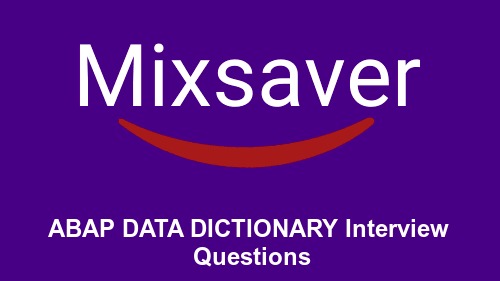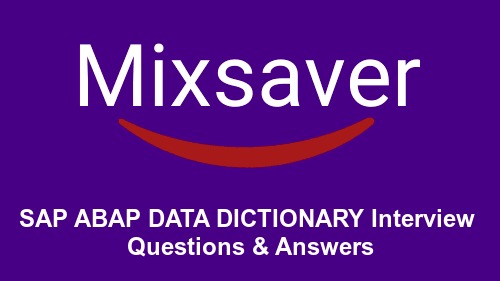1. What is a Data Class?
The Data class determines in which tablespace the table is stored when it is created in the database.
2. What is a Size Category?
The Size category describes the probable space requirement of the table in the database.
3. How Many types of size categories and data classes are there?
There are five size categories (0-4) and 11 data classes, only three of which are appropriate for application tables:
APPL0 - Master data (data frequently accessed but rarely updated)
APPL1 - Transaction data (data that is changed frequently)
APPL2 - Organisational data (customizing data that is entered when the system is configured and then rarely changed)
4. What are control tables?
The values specified for the size category and data class are mapped to database-specific values via control tables.
5. What is the function of the transport system and workbench organizer?
The function of the transport system and the Workbench Organizer is to manage any changes made to objects of the ABAP/4 Development Workbench and to transport these changes between different SAP systems.
6. What is a table pool?
A table pool (or pool) is used to combine several logical tables in the ABAP/4 Dictionary. The definition of a pool consists of at least two key fields and a long argument field (VARDATA).
7. What are pooled tables?
These are logical tables which must be assigned to a table pool when they are defined. Pooled tables can be used to store control data (such as screen sequences or program parameters).
8 .What is a table cluster?
A table cluster combines several logical tables in the ABAP/4 Dictionary.Several logical rows from different cluster tables are brought together in a single physical record. The records from the cluster tables assigned to a cluster are thus stored in a single common table in the database.
9. Which objects are independent transport objects?
Domains, Data elements, Tables, Technical settings for tables,Secondary indexes for transparent tables, Structures, Views,Matchcode objects, Matchcode IDs, Lock objects.
10. What are the Data types of the external layer?
ACCP, CHAR, CLNT, CUKY,CURR, DATS, DEC, FLTP, INT1,INT2, INT4, LANG, LCHR,LRAW, NUMC, PREC, QUAN,RAW ,TIMS, UNIT, VARC.
11. What are the Data types of the ABAP/4 layer?
Possible ABAP/4 data types:
C: Character.
D: Date, format YYYYMMDD.
F: Floating-point number in DOUBLE PRECISION (8 bytes).
I: Integer.
N: Numerical character string of arbitrary length.
P: Amount or counter field (packed; implementation depends on hardware
platform).
S: Time stamp YYYYMMDDHHMMSS.
T: Time of day HHMMSS.
V: Character string of variable length, length is given in the first
two bytes.
X: Hexadecimal (binary) storage.
12. How can we set the tablespaces and extent sizes ?
You can specify the extent sizes and the tablespace (physical storage area in the database) in which a transparent table is to be stored by setting the size category and data class.
13. What is a data dictionary ?
Data dictionary is a central source of data in a data management system. Its main function is to support the .It has details about
What data is contained ?
14. What functions does a data dictionary perform ?
In a data management system, the principal functions performed by the data dictionary are:
- Management of data definitions
- Provision of information for evaluation
- Support for software development
- Support form documentation
- Ensuring that the data definitions are flexible and up-to-date.
15. A field containing currency amounts (data type CURR) must be assigned to a reference table and a reference field. Explain.?
As a reference table, a system table containing all the valid currencies is assigned or any other table which contains a field with the currency key format. This field is called as reference field.
The assignment of the field containing currency amounts to the reference field is made at runtime. The value in the reference field determines the currency of the amount.
16. What is the significance of Technical settings (specified while creating a table in the data dictionary) ?
By specifying technical settings we can control how database tables are created in the database.
The technical settings allows us to
optimize storage space requiremnets
table access behaviour
buffering required
changes to entries logged
17 What is the significance of Delivery Class ?
- The delivery class controls the degree to which the SAP or the customer is responsible for table maintenance
whether SAP provides the table with or without contents.
determines the table type.
determines how the table behaves when it is first installed, at upgrade, when it is transported, and when a client copy is performed.
18. What is the maximum number of structures that can be included in a table or structure
Nine.
19. What are the two methods of modifying Sap standard tables ?
Append Structures and
Customizing Includes.
20. What is the difference between a Substructure and an Append Structure ?
In case of a substructure, the reference originates in the table itself, in the forma of a statement .include... .
In case of an append structure, the table itself remains unchanged and the refrence originates in the append structure.
21. What are the two ways for restricting the value range for a domain ?
By specifying fixed values.
By stipulating a value table.
22. What is a Match Code ?
Match Code is a tool to help us to search for data records in the system. Match codes are an efficient and user-friendly search aid where key of a record is unknown.
23. What are the two levels in defining a Match Code ?
Match Code object
Match Code Id.
24.What is the maximum number of match code Id's that can be defined for one Match code object ?
36. A match code Id is a one character ID which can be a letter or a number.
25. Can we define our own Match Code ID's for SAP Matchcodes ?
Yes, the numbers 0 to 9 are reserved for us to create our own Match Code IDs for a SAP defined Matchcode object.
26. What is an Update type with reference to a Match code ID?
If the data in one of the base tables of a matchcode ID changes, the matchcode data has to be updated. The update type stipulates when the matchcode is to be updated and how it is to be done. The update type also specifies which method is to be used for Building matchcodes . You must specify the update type when you define a matchcode ID.
27. What are conversion routines ?
Non standard conversions from display format to sap internal format and vice-versa are implemented with so called conversion routines.
28. What are Aggregated Objects
Views, matchcodes, and lock objects are also called aggregate objects because they are formed from several related tables.
29. What is a View ?
A view is a logical view on one or more tables. A view on one or more tables i.e, the data from a view is not actually physically stored instead being derived from one or more tables. A view can be used to summarize data which is distributed among several tables
30. How many types of Views are there ?
Database View (SE11)
Database views are implement an inner join, that is, only records of the primary table (selected via the join operation) for which the corresponding records of the secondary tables also exist are fetched. Inconsistencies between primary and secondary table could, therefore, lead to a reduced selection set.
In database views, the join conditions can be formulated using equality relationships between any base fields. In the other types of view, they must be taken from existing foreign keys. That is, tables can only be collected in a maintenance or help view if they are linked to one another via foreign keys.
Help View ( SE54)
Help views are used to output additional information when the online help system is called.
When the F4 button is pressed for a screen field, a check is first made on whether a matchcode is defined for this field. If this is not the case, the help view is displayed in which the check table of the field is the primary table. Thus, for each table no more than one help view can be created, that is, a table can only be primary table in at most one help view.
Projection View
Projection views are used to suppress or mask certain fields in a table (projection), thus minimizing the number of interfaces. This means that only the data that is actually required is exchanged when the database is accessed.
A projection view can draw upon only one table. Selection conditions cannot be specified for projection views.
Maintenance View ( SE54 )
Maintenance views enable a business-oriented approach to looking at data, while at the same time, making it possible to maintain the data involved. Data from several tables can be summarized in a maintenance view and maintained collectively via this view. That is, the data is entered via the view and then distributed to the underlying tables by the system.
31. What is Locking?
When two users simultaneously attempt to access the same data record, this is synchronized by a lock mechanism. When dialog transactions are programmed, locks are set and released by calling certain function modules. These function modules are generated automatically from the definition of so-called lock objects in the ABAP/4 Dictionary. To synchronize the access to a table by setting and removing locks, a Lock object has to be defined in the ABAP/4 Dictionary. Activating the lock object automatically creates function modules for setting and removing locks. These function modules must be included when programming interactive transactions.





